
| Maximum Length | 5.4 miles |
|---|---|
| Maximum Width | 0.75 miles |
| Average Depth | 33 feet |
| Maximum Depth | 66 feet |
| Route Length | 13.4 miles |
Otisco Lake is the easternmost Finger Lake, near Syracuse. The etymology of the lake’s name is a bit more muddy than the previous lakes. One guess is that “Otisco” is derived from ostick, an Onondaga word meaning “low water”.1 It’s tough to nail down a specific etymology because multiple Iroquois tribes had different names for the same lake. In other situations, the name for a lake’s inlet or outlet also applied to the basin.
Looking at the map, it was apparent that this lake would be different from the others. A line of earthwork sliced through the southern part of Otisco Lake. After some research, I found that this is a side effect of the Erie Canal’s construction. Engineers wanted to use Otisco Lake as a reservoir to help inundate the Canal. They built a dam near the lake’s outlet, raising the lake level by several feet. Unfortunately, this flooded a road at the southern end. To replace the flooded road, a causeway was built out of hemlock logs to facilitate crossing the lake.2 It has since been abandoned by motorists, but not by anglers.
This odd structure meant that a circumnavigation was not as simple. Also, the lakes were getting bigger and bigger. I had to make a float plan. Every solo kayaker should be making one and sharing it with people they trust. Here’s the map part of mine that I doodled in MS Paint.
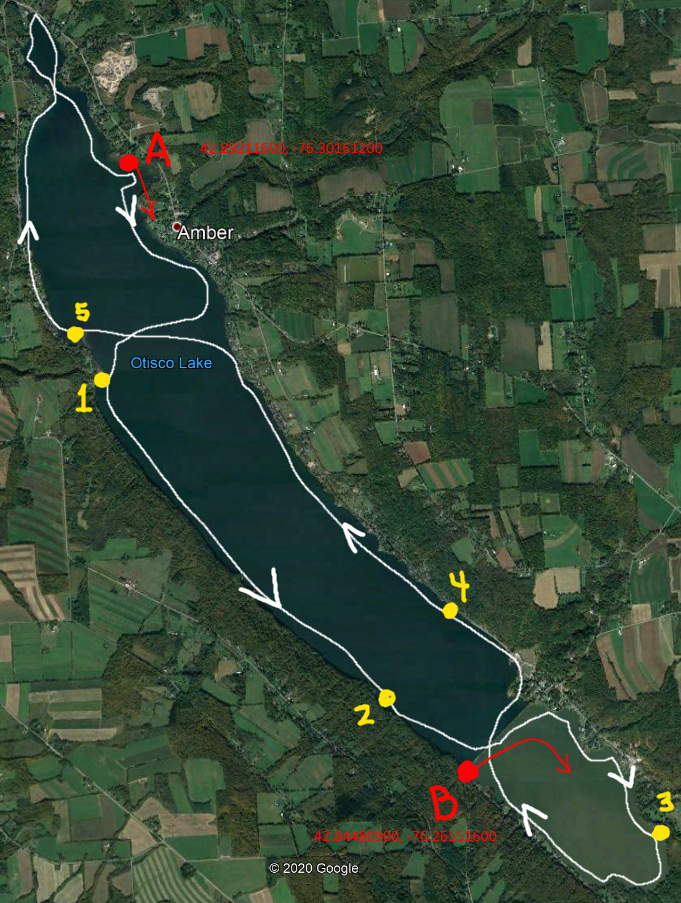
A good float plan should have a map of the planned route, put-in and take-out times/locations, rest stops, and emergency contact information. I told my friend back in Rochester that I estimated it would take me 5 hours and to call 911 if I did not respond by nightfall. This might sound overly cautious, but it really is for the best. What if a drunk boater rammed my kayak and knocked me unconscious? I’d be just bobbing up and down in the waters. Constant vigilance!
The day of my voyage, I woke up to a slightly worrying weather report. The temperature would be a perfect 70 degrees, but accompanied by 20 mph winds and 30 mph gusts! I had never experienced kayaking in winds before, so it was difficult for me to gauge how strongly these winds would affect the water. I had to learn by experience, so I figured I’d just go and see what happens. If it got too windy, I could always just abort, right?
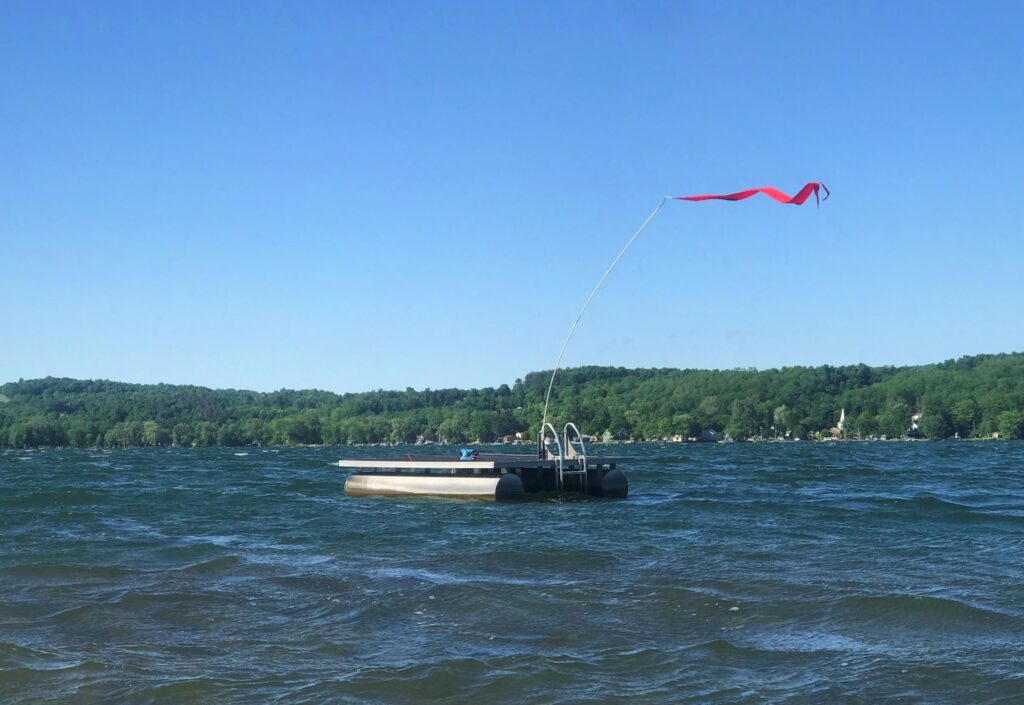
I launched from Otisco Lake Park, situated on the northeastern tip of the lake (labeled A on the float plan). It was difficult hauling the kayak across 500 feet of lawn. Note to self: get a kayak cart! As I reached the shore, the lake welcomed me with a roiling chop. The waters looked angry, goaded by the wind. There weren’t any white caps or spray, so I figured it’d be OK. Off I went.
As I paddled southward, hugging the east shore, I had the wind to my back. As I got out to more open waters, I realized I had forgotten one important aspect of wind: fetch. 20 mph winds might not seem too windy, but if it aligns with the lake, the results are amplified. The longer wind can travel across a body of water, the more opportunity it has to churn up these waters. The result? Big waves!
I’m sure these waves were a joke to motorboats, but I suddenly felt very small along 4 foot high waves that threatened to capsize me. As kayakers, we are always in between swims. I quickly figured out what to do and not to do. For starters, never present your broadside to the waves!
At one point, I stopped for a breather and snack. Foolishly, I had stopped on the windward side of a small peninsula. The kayak quickly weathercocked,
It was an arduous task making my way to the south, even with the wind to my back. I forwent the lateral crossing of my float plan. I felt that the waters out in the middle would be just a bit too gnarly for me. I had to get my sea legs. I learned that it was best to plunge my paddle into the crests of waves, rather than the troughs. Better balance that way and I could push off the wave crests as if they were tiny hills. The winds and waves were a great teacher, if not a bit stern.
As I neared the causeway, dividing the lake into northern and southern sections, the waves were getting bigger! I realized this was due to the waves reflecting off the causeway, rebounding back north. I was dealing with waves sneaking up behind me. Now I had to check for waves coming at me. To make matters harder, my heading toward the causeway channel meant that I was exposing my broadside. Another lesson: always consider the geometry of the lake when it comes to waves.
I was hoping that the southern section would be calmer, since the causeway effectively reset the wind fetch. I was right. After rocketing through the channel, I was welcomed by calm water unfazed by the wind. I breathed a sigh of relief. This was a much needed respite! One thing was odd – the water was exceptionally muddy. The shallow southern section meant that the water column was easier to churn up. Sediment on the floor would be suspended more easily. Also, the causeway prevented the dilution of the turbid water.
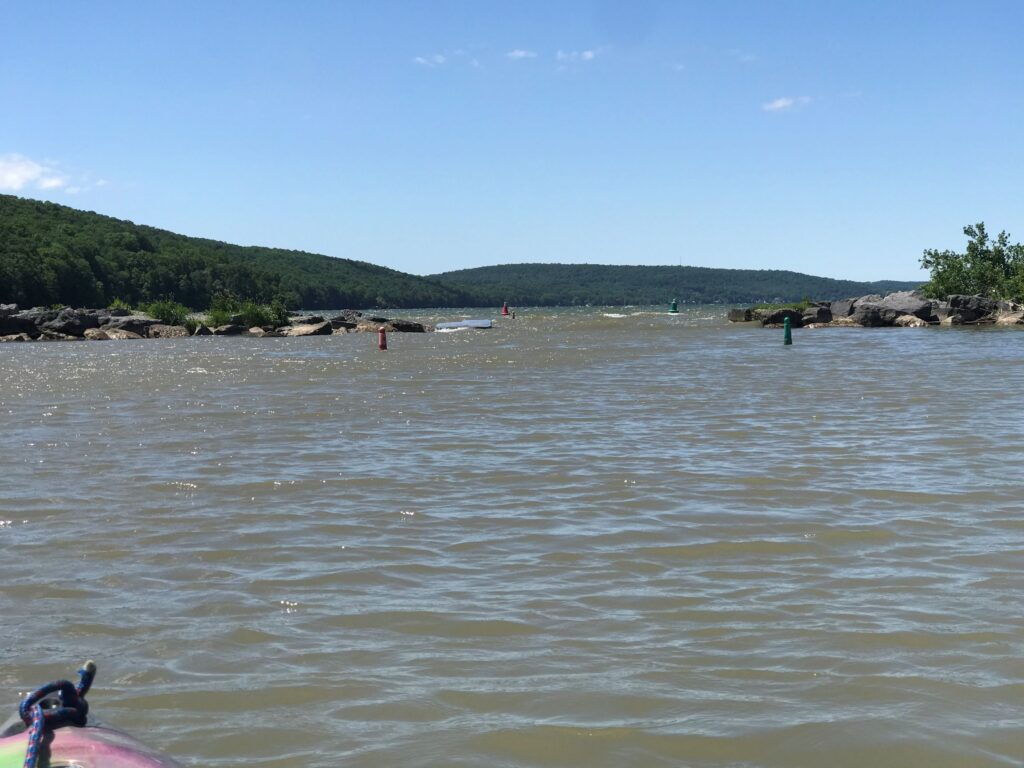
After resting in the comparatively idyllic but turbid southern section, I made my way back to the channel. This time, the water and wind were against me. I was slightly nervous, since the channel was fairly narrow. The narrowness and influx from the northern section made for some standing waves I’d have to fight against. I decided to build up some steam and just punch the channel.
As soon as I broke back into the northern section, I was welcomed by the choppy waves reflecting off the causeway. Now that the wind was against me, it was difficult getting to the western shore without being broadsided by waves. The wind blowing on my paddle blades tired me out, so I feathered3 my paddle shaft. The new angle of the blades threw me off, so I had to relearn my strokes. Here’s a great article on paddling with a feathered shaft.
Paddling north along the western shore was physically tiring, but not as mentally taxing. I became accustomed to the large waves, which became smaller and smaller as the wind fetch decreased. I happened upon a lovely pebble beach with an overlooking cliff. Here, I just laid down staring at the sky.
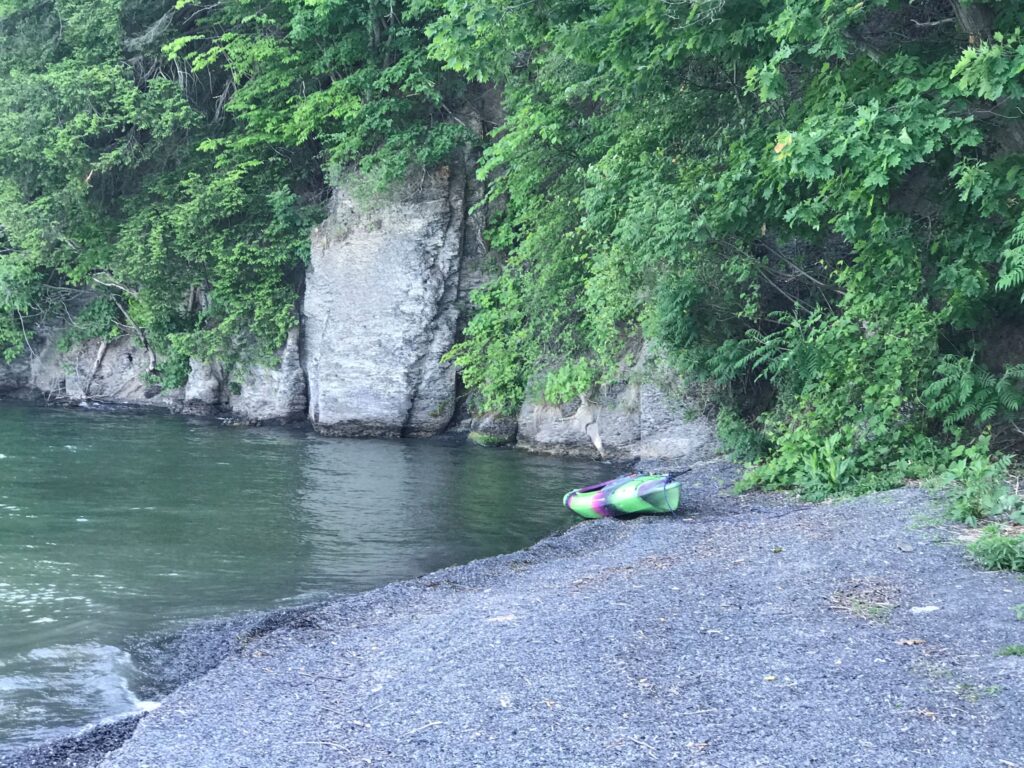
The wind was finally dying down as I reached the northern end. The map showed a chokepoint called the Narrows. I was concerned that there would be some gnarly waves there. But thankfully, since the wind was blowing to the southeast, the fetch was too short to be of any concern. The water was very calm and weedy. I spotted a harvester trawling along like an aquatic lawnmower. Gotta keep the invasive plants at bay!
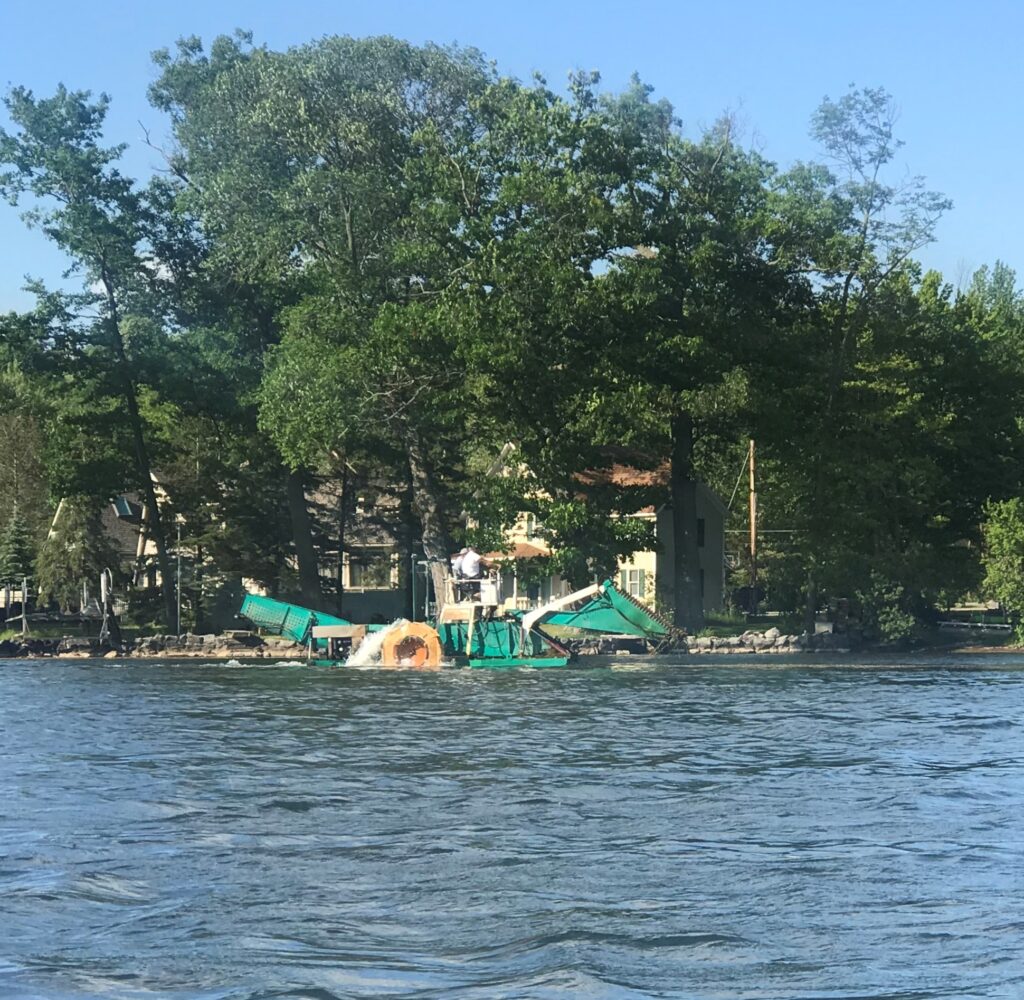
After rounding the northern end, it was a short paddle to the take-out. As I beached, I just sat there for several minutes, exhausted but proud. I had bagged my third Finger! I also reflected on how much I had learned. This post’s length reflects that. Otisco Lake had been a great teacher. Here are Otisco’s lessons:
- Be mindful of wind fetch. The direction in which wind travels is just as important as the wind speed.
- Be mindful of lake geometry. Waves reflect! Rest on leeward beaches, not windward.
- Time paddle strokes so that the blades plunge into wave crests, not troughs.
So far, Otisco Lake had been the hardest yet the most rewarding. It took me exactly 6 hours to cover 13.4 miles. My average speed, impeded by wind and waves, decreased to 2.23 mph. Will Hemlock Lake be harder?
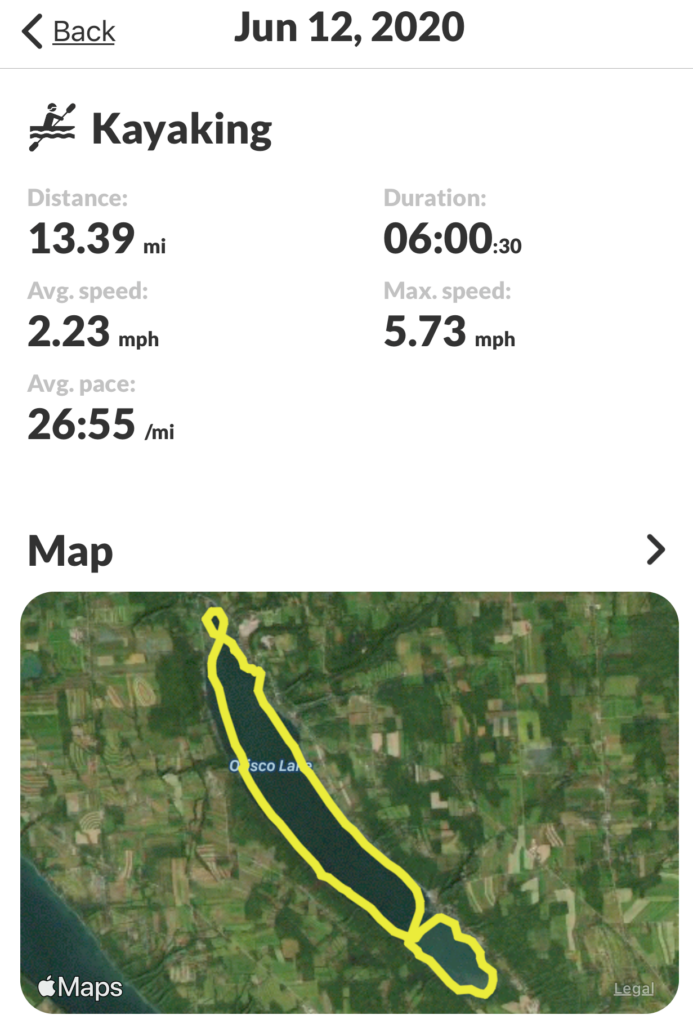
Beauchamp, W.M. Aboriginal Place Names of New York. New York State Education Department, 1907. p. 157 ↩︎Figura, David. “CNY shoreline hot spot: The causeway on Otisco Lake (first in a series)” https://www.syracuse.com/outdoors/2012/06/cny_shoreline_hot_spots_the_ca.html ↩︎Twisting the paddle shaft so that the blades aren’t perpendicular to the wind ↩︎

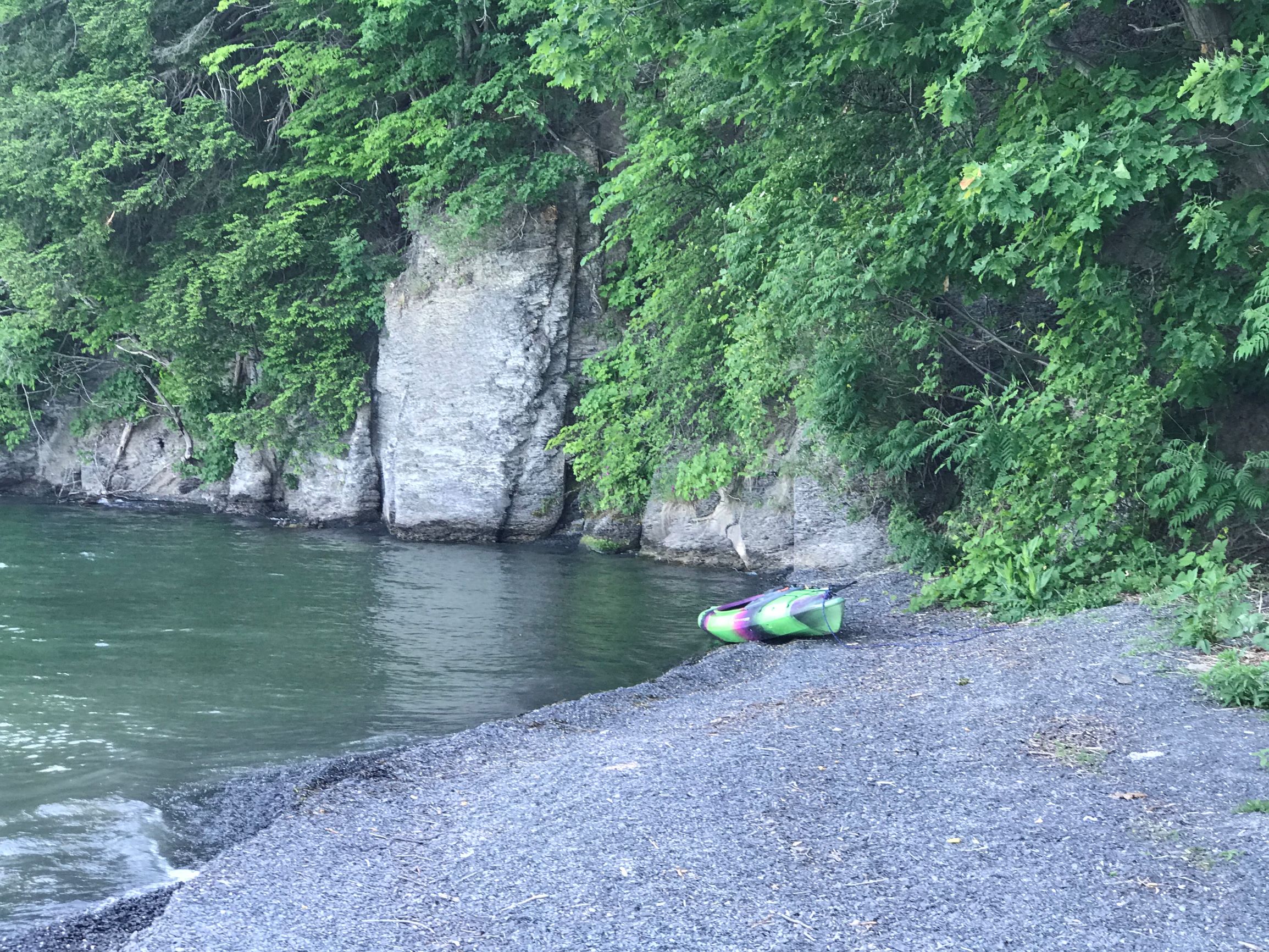
Comments are closed.